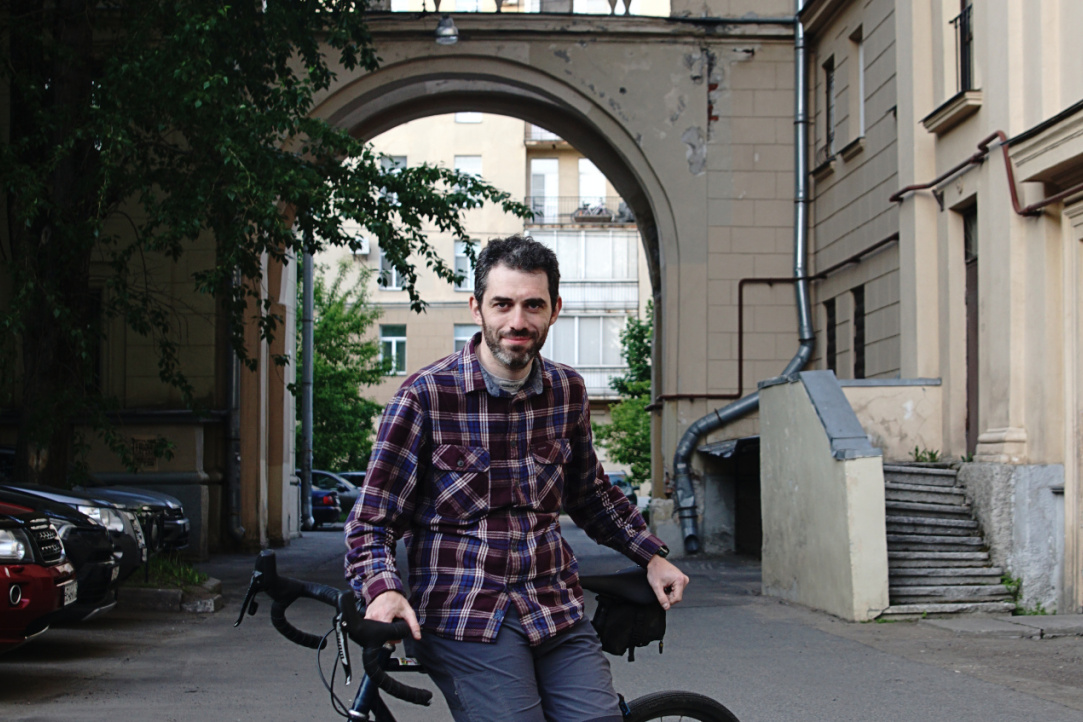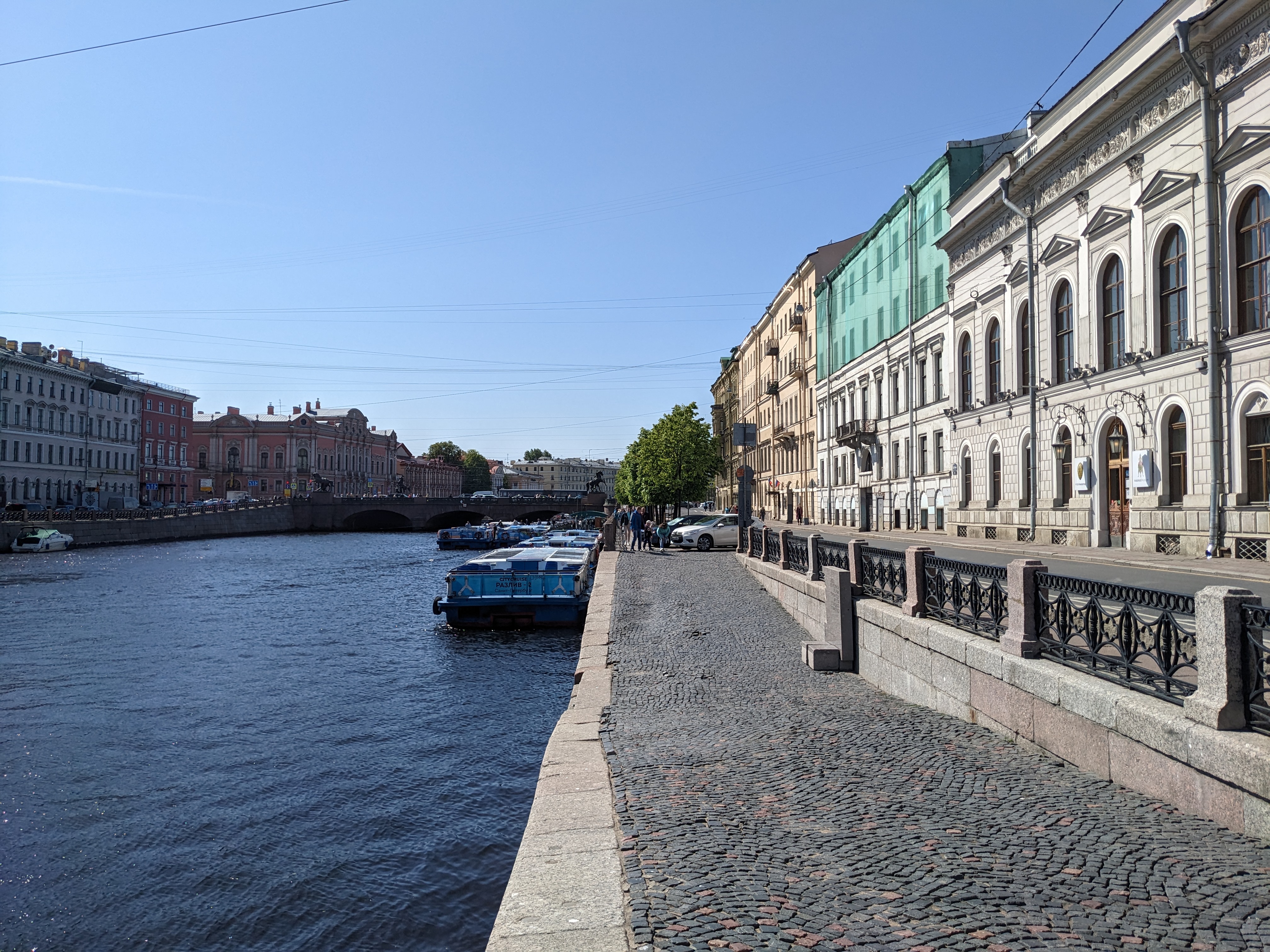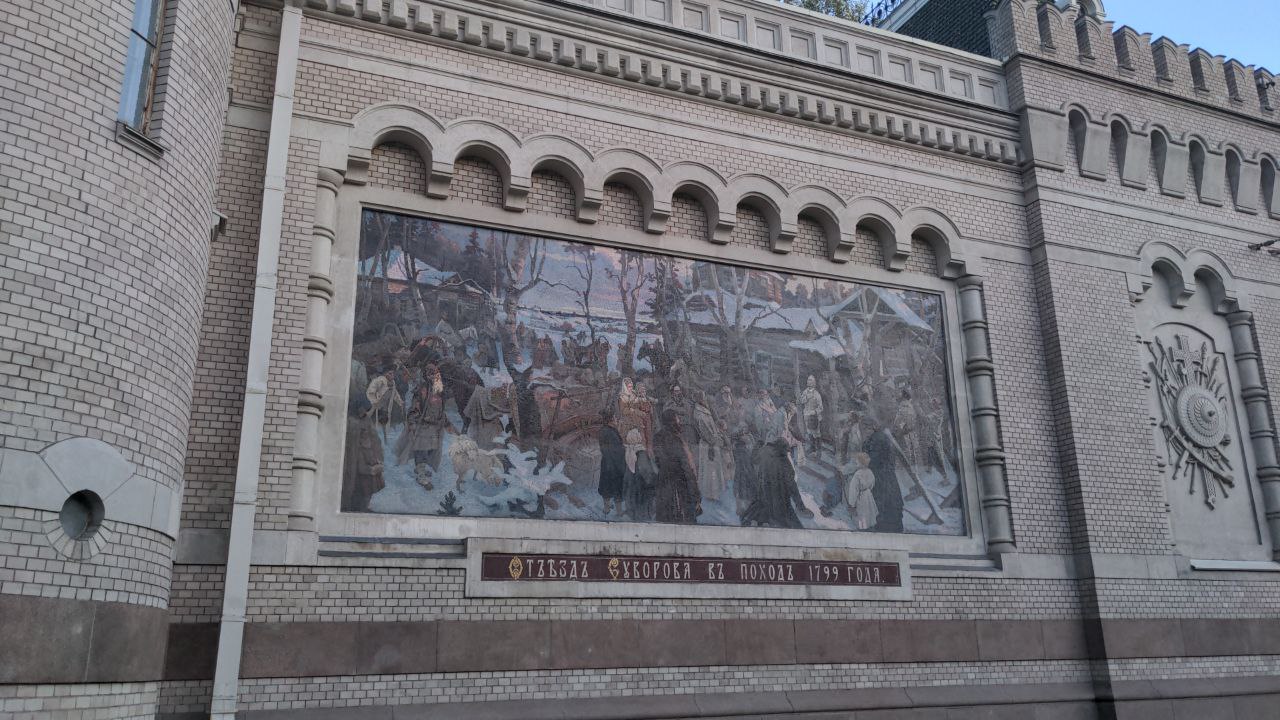'City Legends': Physicist Igor Shenderovich on His Favourite Places in St Petersburg
St Petersburg can be very different—dress-up, mysterious and even funny. One story overlaps the other, the most important thing is to notice the details. This time, we will explore St Petersburg with Igor Shenderovich, Academic Supervisor of the Bachelor's programme 'Physics'. Learn in which building you can find a yearnful lion, what Mikhail Zoshchenko and the Suvorov Museum have in common, and why arches in the Malaya Okhta are popular in the interview.

A Place That Inspired Research
It is a whole district—approximately, from Chernyshevskaya to the corner of Fontanka and Nevsky Prospekt. Everything happened to be here: my school, the Laboratory of Mathematical Problems of Physics DSMI RAS and a shop of old technical books.
I spent my school years on Kirochnaya Street—there is Physics and Mathematics Lyceum № 239. There, my interest in physics appeared—I was inspired by my teacher Victor Terekhov. He was an empathetic teacher. He did not pressure anyone and understood that physics wasn't interesting for everyone—even at mathematical school. But he spent hours talking to those who showed at least a minimum interest in physics.
As a student, I often visited a shop of old technical books at the corner of Liteyny Avenue and Zhukovsky Street. There, they sold good books on mathematics and physics for peanuts. It was an old-fashioned place. There were big stacks, and I could spend hours digging around. The funniest part started when you liked a book. You had to come up to a seller, they would write out a check. Then, you went to a cashier, paid and returned to the seller to get the book. It was very common in Soviet shops!
I worked on my thesis and research at the laboratory of the Steklov Mathematical Institute. This is just opposite the Anichkov Palace. This was the place where I met Ludvig Faddeev, a famous mathematical physicist. We respectfully spoke a lot about him. He was very active! Looking at Mr Faddev, I was thinking that I would like to engage in science. If not with him, then with one of his mentees. This is exactly what happened. Later, Mr Faddev himself became a reviewer of my thesis.

My Favourite Building in St Petersburg
I have a favourite graphic artist, Yevgeny Ukhnalyov, who drew St Petersburg quite a lot. One of his pictures depicts an overgrown arch with a lion which leads to a dark gateway. I remember this lion very vividly: its muzzle expresses very non-trivial emotions. It was very whiny...
I had been trying to find this house for a very long time and once, I accidentally passed it by on my bike. It is located at the embankment of the Pryazhka River, near the Admiralty Shipyards. The picture by Ukhnalyov depicted the atmosphere of those places quite accurately. The same dark gateway, an arch behind which you cannot see a yard, and a yearnful eye-catching lion. Later, in his memoirs, I read that the picture had also started with the lion. The artist sketched it with coal on the package of 'Shipka'.
A Place I'd Like to Tell Everyone About
Near the Tauride Garden, there is the Suvorov Museum. I do not remember anything about it because I came there for the last time as a child. The museum's fate is not simple: in the 1920s, the Bolshevists sold a significant part of its collection. It is like a box of sweets but an empty one.
The walls of this museum are decorated by two big mosaic panels—'Suvorov Crossing the Alps' and 'Suvorov Leaving for Camping'. The second one depicts a winter village, huts and a crowd of peasants, and in the foreground, there is a holiday tree. It looks wretched, to say the least. It is difficult to understand how it got there. But there is a clue to solve the story's mystery.

The thing is that the panels were created by mosaic artist Mikhail Zoshchenko. The surname is not an accident—this is the father of a famous author. He allowed his little son Misha to lay out the holiday tree on this huge panel for the Suvorov Museum. This episode vividly shows how a city can be a conductor and connect different times, art styles and generations. When the layers are glued together, you cannot ignore them—they give you new creative ideas.
As for the story with the holiday tree, you can read about it in detail in the autobiographical novel by Zoshchenko 'Before the Sunrise'. It is amazing because of its context and dramatic fate. In 1943, only a few chapters were published. Then, the book was prohibited, and Zoshchenko himself was harassed.
A Place I Want to Keep Secret
This place simply does not exist anymore! I would keep the New Holland a secret—the one before the reconstruction. The place is absolutely magical and attractive. It is a perfect triangle if you look at it from above. The building of New Holland itself is very old, it was built back in the 18th century. It remembers more about St Petersburg than others. Of course, there is also the Peter and Paul Fortress but this spirit was taken from there by tourists. The New Holland lives in my memory—deserted.
Before the fire, New Holland was used as a warehouse of the Baltic Fleet, and the island was closed. If it is not easy to get into a place, it always attracts more, doesn't it? In winter, when the canal was covered with ice, I went to the Vallen-Delamot's Arch and climbed up. It was pretty bad inside—the roof fell in some places, and the beams were rotten but there was an amazing view of the Mariinsky Theatre and Kryukov Canal. Of course, it is great that the New Holland was renovated and found a new application. But I would like to keep something from that old place so that its mystery was just for me.
The Place with My Favourite History
Probably, the Malaya Okhta district where I live. They have started to build it up relatively recently — in the 30s and continued only after the Second World War. Grigory Simonov got into this task. His other constructivist buildings were located around Tractornaya and Narvskaya Streets. These buildings—both in the Malaya Okhta and at Narvskaya Street—stand out with their arches. They greatly match the pictures by Malevich. The heads of 'Peasants' along the contour coincide one-to-one with these arches. It’s hardly a mere similarity. Mr Simonov was likely inspired by Malevich's works.
These buildings with arches in the Malaya Okhta are paradoxical in their own way as they have terraces of the Mediterranean kind. Just like Roman and Greek houses. Why they have to be there is a good question. This district is cold, the wind is constantly blowing from the Neva River. Nine months of the year, these terraces are flooded by rain and covered in snow. In such weather, you can't sunbathe for sure. Then, I realised: it is a common thing in the Soviet architecture of the 30s. Back then, there was an idea that a person was in control of everything, even nature. If we build a house with a southern terrace, the climate will take heed of it. But no one listened to the architects...
The arches in the Malaya Okhta were featured in the poem by Joseph Brodsky. 'Paradise of workshops and utopia of factories', he wrote about this district. The poet came here to visit a girl who lived in a dormitory of Hydromet—this is almost next to my house. Now, at Stakhanovites Street, you can find a monument dedicated to Joseph Brodsky with the lines: 'So now, I've passed the Malaya Okhta through a thousand arches'.
My Favourite Place in the Leningrad Region
The North of the Leningrad region is something unique and very powerful. But it is not easy to feel this power. Once, I spent a week on the shore of the freezing Ladoga—literally a hundred meters from the lake. The wind was strong, and Ladoga was constantly buzzing as an aircraft engine. One morning, I woke up and realised that the noise had stopped. I came to the shore and saw the waves frozen in movement. This is where I managed to catch the power which the sailors definitely felt crossing Ladoga from West to East.
From Ladoga, you can come up with a quite long itinerary. To start with, go to the deserted shore of the lake. Then drive through the Karelian Isthmus, and look at the destroyed foundations of Finnish houses which have remained there since the Soviet-Finnish war. It's very hard for me to look at it as I feel the centuries-long work of peasants who were dragged from the habitable place behind it. If you go further, from West to East, Komarovo starts. It is a special place for cultural and academic St Petersburg. The upper part of the village was home to composers, poets, artists and writers, and in the lower part, there were summer houses for scientists. It is quite possible to explore all of it in a couple of days.
What I Hate About St Petersburg
Because 'it is small and surrounded by Leningrad from all sides' as Samuil Lurie, a publicist, wrote. For me, it is right both literally and figuratively.
If you take a closer look at the city, its historical centre is surrounded by grey industrial belt. Most of the buildings which are part of it turned into barracks or car service centres and haven't been used for their intended purpose for a very long time. As a result, people who live outside the city centre are almost completely cut off from it. They have to spend at least an hour to pass this belt in the morning on their way to work, and then get back. This is plenty of time!
St Petersburg is absorbed by the industrial zone but it clearly tries to get out of it. Lifeless spaces turn into something useful. This is the fate of the New Holland, 'Sevkabel Port' and gas storages in the Obvodny Channel. The city is obviously changing but not always as we would like it to. And not as fast for sure.
Figuratively, getting out of Leningrad is easier than it seems. Anyone who wants to get in touch with St Petersburg can do it without much difficulty. In the end, St Petersburg is such a powerful source of its authenticity that it will overcome and survive Leningrad. We are here only for some time as well but the city will remain.
What I Love About St Petersburg
Because it is so many-sided. Here, splendour is found side by side with complete devastation, sometimes even within one street. St Petersburg also does not look like a city from a postcard but it is for the better—it would be hard for me to live in such a place.
St Petersburg combines a lot of characters and districts every of which is good in its own way. There is a place in the city for every mood. If you want Moscow fuss, you go to the Nevsky Prospekt—by the way, this is why I seldom go there. If you want alcoholic romanticism, you should go to the far Kolomna, and for aristocratic—to the near one. You can find modern chic on Petrogradka. If you want to feel like you are on a different planet—go to Vasilievsky Island. Once, I felt like in another city when I got there. I was going down the Sredny Prospekt and suddenly saw some boots behind the glass of the window. They were supplemented with the advertisement written by hand: 'Lowest prices on the island'. So people don't think about anything 'outside the island'. Nothing else exists, they really live on the island!
Joseph Brodsky or Lev Loseff?
Of course, Loseff is somewhere between a professor and a poet. After moving to the USA, he taught Russian literature at Dartmouth College and wrote works on 'The Tale of Igor's Campaign' and many others. Long story short, he was a completely academic person—and suddenly, he wrote poems.
Obviously, I learnt about Brodsky earlier, when I was a school student, but then, people started talking about him a lot. What seemed attractive at the beginning faded away. Brodsky is very unstable: he wrote a lot of good poems but there are enough bad ones too. His intonation is tone heart-rending—both in his poems and his voice which you can hear in recordings. Brodsky is one of those who can go out on stage. Loseff keeps the detached tone of a calm professor though he writes about very unsettled things.
Loseff uses a lot of irony, and he does not hesitate to play with his readers. For instance, the poem 'Still Life of a St Petersburg School'. When published in the journal, it was put in a frame. Before the poem, you can find the following lines: 'A distinguishing feature of a still life of a St Petersburg school is that they stay unfinished'. This poem is also unfinished, and a little abandoned. Everything Loseff does is the same. You have to decipher some things and guess the others. It is similar to a lecture by a good professor. There are always things that a student has to think over himself.
Moreover, in his poems, Loseff describes the dilemma which I cannot solve: how our city is called for me. I was born in Leningrad, and I live in St Petersburg but how much it resembles Petersburg or Leningrad is a good question. Loseff found an answer in the poem 'Untitled'—perhaps, that is why it is so dear to me. The solution is in these lines:
What is the country called?
Why would you need these names?
I am from a country, comrade,
where there are no roads leading to Rome,
where the smoke in the sky never vanishes
and the snow never melts.
Igor Shenderovich

